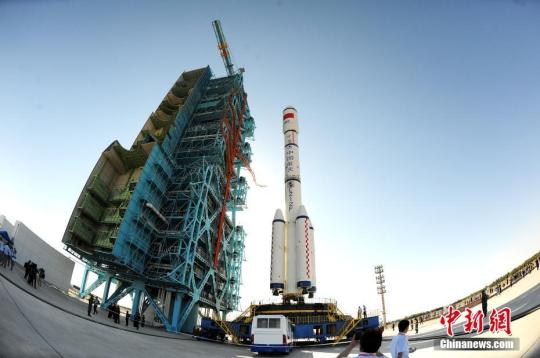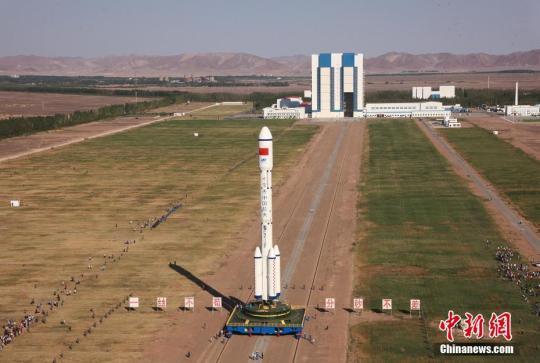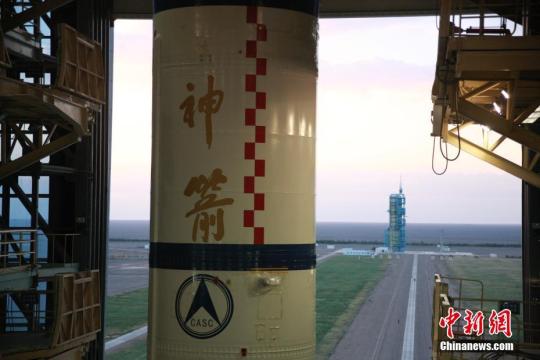Secret
Temple on the second space laboratory: how much cattle? | second | space station _ news
 Temple on the second space laboratory with the long second f T2 vertical transport to the launch Tower. Sun Hao photography
Temple on the second space laboratory with the long second f T2 vertical transport to the launch Tower. Sun Hao photographyBeijing, September 15, after an extended service for 2.5 years, and China's first space laboratory Temple on the first "mission accomplished." And is about to launch the relay--"temple on the second" space lab, you will create more "firsts", in addition to confirmed astronauts medium-term presence in orbit, also conducting 14 experiments involved eight major fields.
According to plan, "temple on the second" space lab will be launched in Beijing on September 15, at 22:04. This year October, China will launches "Shenzhou 11th," manned spacecraft, and "Temple second," space laboratory for docking, for 30 days of astronaut medium-term resides test; 2017, "March seventh," rocket will launches "days boat first," freight spacecraft, and "Temple second," for docking, for advance agent in rail fill added, station built operation key technology of validation. Around 2020, China aims to build a permanent space station.
"Temple on the second" new devices on
"Temple on the second" and "temple on the first" are both automatically runs, short for long-term on-orbit manned spacecraft, is preparing for future long-term space station construction. In comparison, an "intrinsic" has changed a lot.
Previously published news from the China Aerospace Science and technology group, "temple on the second" great improvement is more luxurious, increase the loading capacity, internal environment. It is worth mentioning that, "temple on the second" system design is modular, which means that it can be quickly replaced when problems occur and in-orbit repair, this area was the first in the domestic space.
In addition, in order to facilitate astronauts living in space, "temple on the second" a lot more intimate design. Academy of China Aerospace Science and technology group "temple on the second" space laboratory Zhu Congpeng, Chief Architect, said in an interview: "we want to people-oriented, to astronauts living and creating a better work environment. ”
"Temple on the second" multifunctional platform used to expand for the first time, the astronauts can write, eat, do science experiments, life work balance; communications for astronauts equipped with a Bluetooth headset and Bluetooth stereo; replaced carpet with floor; the cabin lighting with beige colors, the brightness can be adjusted manually, and for each of the astronauts installed a bedside lamp.
In fact, 30-day space hosting is not only a test of the astronauts themselves, new challenges for China's manned space technology. How to provide a suitable living environment for a long time, how long to provide supplies, including water, are in "temple on the second" tasks have been verified.

Temple on the second space laboratory with the long second f T2 vertical transport to the launch Tower. Sun Hao photography
"Temple on the second" new experiments on
Although the "temple on the first", "temple on the second" all belong to the space lab, but the latter is more formal, or "temple on the second" is the real sense of the space lab.
On June 2, the Chinese Academy of Sciences, engineering and technology center of academician Gu Yidong, Senior Adviser on space applications introduced the "temple on the second" space science missions.
For example, "air-ground quantum key distribution with laser communications experiment", key distribution is the "unconditional" key steps to secure quantum communication, this test will verify the core of quantum key distribution and transfer keys between heaven and Earth.
Another example is "polarization detection of gamma-ray bursts" project, the gamma-ray bursts and solar flares are polarization observations with high sensitivity. "Is expected to open up new Windows for polarization detection of gamma-ray astronomy. "Gu Yidong said. "Temple on the second" carrying gamma ray burst detection equipment by the Chinese Academy of Sciences and Switzerland jointly developed, University of Geneva, this piece of equipment than in the past of similar instruments high detection efficiency of dozens of times, our scientists studies reveal the structure, origin and evolution of the universe.
In addition, the "temple on the second" also will be powered by the world's first cold-atomic clocks, "experimental study of thermocapillary convection of liquid bridge", "sample material space growth", "space culture of higher plants" and other projects.
"Temple on the second" thermocapillary convection space experiment Project Director, designer, Institute of mechanics, Chinese Academy of Sciences researcher Kang Qi explained that in order to produce high quality semiconductor materials, scientifically controlled Silicon during crystal growth buoyant convection and thermal capillary convection effects, and unique micro-gravity environment of space will give scientists an in-depth analysis of thermocapillary convection process.
In this flight, "temple on the second" will also release an accompanying satellite, which is a micro satellite, equipped with multiple test load, and have strong ability of orbit, with its space mission flexibility and mobility. Concomitant satellite will be carried out during the mission flying over the observation of the combination of space experiments and spacecraft technology provides support and develops space technology applications.

Temple on the second space laboratory with the long second f T2 vertical transport to the launch Tower. Sun Hao photography
Differences between space lab and space station
Lab space laboratory was built in space, this special lab needs to launch unmanned space laboratory, and then manned spacecraft into space launch vehicles, and stays in the laboratory of unmanned space rendezvous and docking in orbit. Next, astronauts from the spaceship into space laboratory work, then take the shuttle to return to Earth after completion. Therefore, China launch "temple on the second", and will be launched "Shenzhou 11th" manned spacecraft, with the "temple on the second" dock to complete construction of the space laboratory.
Means available to astronauts and space station visits, long-term living and working spacecraft. Greatest feature is the size of the space station and the large, in-orbit operation of time, such as the United States, and Russia, and Japan, and Canada, and Brazil and the European Space Agency to build the international space station, has worked with humans for 16 years.
Space lab like the station's predecessor, for the development of space stations, transition from a manned spacecraft to test spacecraft for manned space infrastructure. The former is to construct more complex space station made preparations. (End)
Responsible editor: Xiang Changming SN123
Article keywords:Temple on the second space station
I want feedback
Save a Web page
International online
揭秘
天宫二号空间实验室:到底有多牛?|
天宫二号|空间站_新闻资讯
 天宫二号空间实验室与长征二号F T2火箭垂直转运至发射塔架。 孙浩摄
天宫二号空间实验室与长征二号F T2火箭垂直转运至发射塔架。 孙浩摄 中新网9月15日电 在超期服役长达两年半之后,中国第一个空间实验室天宫一号“完成使命”。而即将升空的接力者——“天宫二号”空间实验室,则将开创更多“第一次”,除了要印证航天员在轨中期驻留,还要开展14项实验,涉及八大领域。
按计划,“天宫二号”空间实验室将于北京时间9月15日22时04分发射。今年10月,中国将发射“神舟十一号”载人飞船,与“天宫二号”空间实验室进行对接,进行30天的航天员中期驻留试验;2017年,“长征七号”火箭将发射“天舟一号”货运飞船,与“天宫二号”进行对接,进行推进剂在轨补加等空间站建造运营关键技术的验证。其目的是为了中国将在2020年前后建成的永久性空间站。
“天宫二号”上的新设备
“天宫二号”与“天宫一号”相同,均为长期在轨自动运行、短期载人的飞行器,是为未来的长期性空间站建设做准备。但两者相比,“内在”的变化很大。
从中国航天科技集团此前发布的消息来看,“天宫二号”较大的改进是装备更豪华、装载量提高、内部环境更好。值得一提的是,“天宫二号”的系统设计是模块化的,也就是说它出现问题时可以快速更换和在轨维修,这在国内空间领域属于首创。
此外,为了方便航天员太空生活,“天宫二号”在内部增加了很多贴心的设计。中国航天科技集团五院“天宫二号”空间实验室总设计师朱枞鹏在接受采访时介绍说:“我们要以人为本,给航天员创造一个更好的生活和工作环境。”
“天宫二号”首次使用可展开的多功能小平台,航天员可以在上面写字、吃饭、做科学实验,生活工作两不误;通信方面为航天员配备了蓝牙耳机和蓝牙音响;用地板取代了地毯;舱内灯光采用米黄色色调,亮度可手动调节,并为每个航天员安装了床前灯。
事实上,30天的太空驻留不仅是对航天员本身的考验,也是对中国载人航天技术全新的挑战。如何长时间提供适合人生活的环境,如何长时间提供包括水在内的物资供给,都将在“天宫二号”任务中得到验证。

天宫二号空间实验室与长征二号F T2火箭垂直转运至发射塔架。 孙浩摄
“天宫二号”上的新实验
虽然“天宫一号”、“天宫二号”都属于空间实验室,但后者更为正规,或者说“天宫二号”才是真正意义上的空间实验室。
6月2日,中国科学院空间应用工程与技术中心高级顾问顾逸东院士介绍了“天宫二号”的部分空间科学任务。
比如“空—地量子密钥分配与激光通信试验”,密钥分发是实现“无条件”安全的量子通信的关键步骤,这项试验将验证量子密钥分发的核心环节,在天地间传输密钥。
再如“伽马暴偏振探测”项目,将对伽马暴和太阳耀斑进行高灵敏度偏振观测。“可望开辟伽玛射线偏振探测天文新窗口。”顾逸东说。“天宫二号”搭载的伽马暴探测设备由中国科学院与瑞士日内瓦大学联合研制,这台设备比过去国际上类似仪器的探测效率高数十倍,中欧科学家合作研究揭示宇宙结构、起源、演化问题。
此外,“天宫二号”还将搭载全球首台冷原子钟,开展“液桥热毛细对流实验研究”、“多样品材料空间生长实验”、“空间高等植物培养实验”等项目。
“天宫二号”热毛细对流空间实验项目主任设计师、中国科学院力学研究所研究员康琦解释,为生产出高质量的半导体材料,就要科学控制单晶硅在晶体生长过程中浮力对流和热毛细对流的影响,而太空特有的微重力环境将使科学家深入剖析热毛细对流的真实过程。
这次飞行中,“天宫二号”还将释放一颗伴随卫星,这是一颗微纳卫星,搭载多个试验载荷,并具备较强的变轨能力,具备开展空间任务的灵活性与机动性。伴随卫星将在任务期间开展对空间组合体的飞越观测等试验,为主航天器的技术试验提供支持,并拓展空间技术应用。

天宫二号空间实验室与长征二号F T2火箭垂直转运至发射塔架。 孙浩摄
空间实验室与空间站的区别
空间实验室是建造在太空中的实验室,这种特殊的实验室需要先发射无人空间实验室,然后再用运载火箭将载人飞船送入太空,与停留在轨道上的无人空间实验室交会对接。接下来,航天员从飞船中进入空间实验室,开展工作,完成工作后再乘飞船返回地球。因此,中国在发射“天宫二号”后,还将发射“神舟十一号”载人飞船,与“天宫二号”对接,从而完成空间实验室的建造。
而空间站是指可供多名航天员巡访、长期工作和居住生活的载人航天器。空间站最大的特点就是规模和体积庞大、在轨运行的时间久,比如由美国、俄罗斯、日本、加拿大、巴西和欧洲空间局共同建造的国际空间站,已经为人类工作了16个年头。
空间实验室像是空间站的前身,为发展空间站,从载人飞船过渡到载人航天基础设施的试验性航天器。前者是为建造复杂程度更高的空间站所做准备工作。(完)
责任编辑:向昌明 SN123
文章关键词: 天宫二号 空间站
我要反馈
保存网页
国际在线